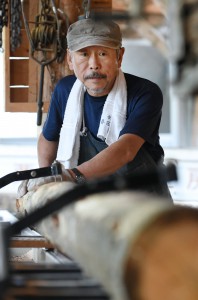
Studio makes canoes and kayaks out of locally-grown timbers. The ships are light and easy to handle (in Hanno-shi, Saitama Prefecture)
Kotaro Yamada
– Naguri Canoe Studio (Hanno-shi, Saitama Prefecture) –
Hanno-shi, Saitama Prefecture, is only about one hour ride on a train from the heart of Tokyo, but three-fourth of the city is forest land. The city had flourished with the forestry and the wood processing industry until 1964, when the Japanese government fully liberalized wood import to Japan. Today, some people are gathering at Naguri Canoe Studio, a non-profit organization (NPO) established by local residents, to bring back the prosperity by promoting canoes made out of locally-grown timber.
The NPO uses timber of Japanese cedar and cypress obtained from forest-thinning to build canoes. At the studio, they cut the logs into boards of 4 meters in length, 15 millimeters in width and 6 millimeters in thickness, and glue them together in the shape of the boat. The surface of the boat is then reinforced using fiber-reinforced plastic (FRP) coating. It takes approximately 30 days to build one regular canoe.
The wooden canoes are very light (only about 20 kilograms) and easy to carry. One four-meter-long canoe fits two adults and one child.
The studio also sells do-it-yourself kits for those who want to experience fun of making their own wood canoes and helps them assemble the canoes at the studio. So far, in about past 20 years, approximately 700 people bought the kit and enjoyed the woodwork.
“Ciders produced in this area are soft and easily bent. So they are perfect materials for a small boat,” explained Naoyuki Yamada, a 66-year-old representative of the NPO. The NPO can also build kayaks and yachts by hand.
Despite being only 50 kilometers away from the heart of Tokyo, the city of Hanno has forest land of over 20,000 hectares in total. Curator of the city museum, Shingo Yanagido, 54, said, “In Meiji era and from then on, the area served as a leading producer of materials for buildings and houses in Tokyo. The city literally supported the expansion of Tokyo and so, the forestry industry was a core industry here.”
Yamada started to build canoes in Hanno-shi in 1988. He and his partners also offer woodworking lessons in order to increase the number of fans of the local wood timber. “Wood has been supporting our lives for a long time. I make canoes and use wood stoves, hoping that, this way, I can gradually bring back the life with wood,” he said.

Naguri Kurashi-no Tenjishitsu is a museum that explains history of local forestry industry. There are displays of old tools and equipment.
(June 21, 2015)



